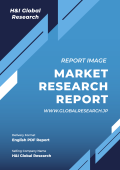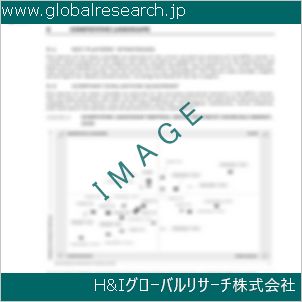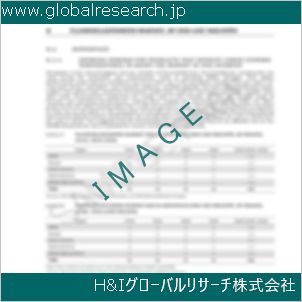Table of Contents
1 Industry Overview of Leadmonoxide
1.1 Definition and Specifications of Leadmonoxide
1.1.1 Definition of Leadmonoxide
1.1.2 Specifications of Leadmonoxide
1.2 Classification of Leadmonoxide
1.3 Applications of Leadmonoxide
1.3.1 Nuclear Application
1.3.2 Non-Nuclear Application
1.4 Industry Chain Structure of Leadmonoxide
1.5 Industry Overview and Major Regions Status of Leadmonoxide
1.5.1 Industry Overview of Leadmonoxide
1.5.2 Global Major Regions Status of Leadmonoxide
1.6 Industry Policy Analysis of Leadmonoxide
1.7 Industry News Analysis of Leadmonoxide
2 Manufacturing Cost Structure Analysis of Leadmonoxide
2.1 Raw Material Suppliers and Price Analysis of Leadmonoxide
2.2 Equipment Suppliers and Price Analysis of Leadmonoxide
2.3 Labor Cost Analysis of Leadmonoxide
2.4 Other Costs Analysis of Leadmonoxide
2.5 Manufacturing Cost Structure Analysis of Leadmonoxide
2.6 Manufacturing Process Analysis of Leadmonoxide
3 Technical Data and Manufacturing Plants Analysis of Leadmonoxide
3.1 Capacity and Commercial Production Date of Global Leadmonoxide Major Manufacturers in 2023
3.2 Manufacturing Plants Distribution of Global Leadmonoxide Major Manufacturers in 2023
3.3 R&D Status and Technology Source of Global Leadmonoxide Major Manufacturers in 2023
3.4 Raw Materials Sources Analysis of Global Leadmonoxide Major Manufacturers in 2023
4 Capacity, Production and Revenue Analysis of Leadmonoxide by Regions, Types and Manufacturers
4.1 Global Capacity, Production and Revenue of Leadmonoxide by Regions 2019-2024
4.2 Global and Major Regions Capacity, Production, Revenue and Growth Rate of Leadmonoxide 2019-2024
4.3 Global Capacity, Production and Revenue of Leadmonoxide by Types 2019-2024
4.4 Global Capacity, Production and Revenue of Leadmonoxide by Manufacturers 2019-2024
5 Price, Cost, Gross and Gross Margin Analysis of Leadmonoxide by Regions, Types and Manufacturers
5.1 Price, Cost, Gross and Gross Margin Analysis of Leadmonoxide by Regions 2019-2024
5.2 Price, Cost, Gross and Gross Margin Analysis of Leadmonoxide by Types 2019-2024
5.3 Price, Cost, Gross and Gross Margin Analysis of Leadmonoxide by Manufacturers 2019-2024
6 Consumption Volume, Consumption Value and Sale Price Analysis of Leadmonoxide by Regions, Types and Applications
6.1 Global Consumption Volume and Consumption Value of Leadmonoxide by Regions 2019-2024
6.2 Global and Major Regions Consumption Volume, Consumption Value and Growth Rate of Leadmonoxide 2019-2024
6.3 Global Consumption Volume and Consumption Value of Leadmonoxide by Types 2019-2024
6.4 Global Consumption Volume and Consumption Value of Leadmonoxide by Applications 2019-2024
6.5 Sale Price of Leadmonoxide by Regions 2019-2024
6.6 Sale Price of Leadmonoxide by Types 2019-2024
6.7 Sale Price of Leadmonoxide by Applications 2019-2024
6.8 Market Share Analysis of Leadmonoxide by Different Sale Price Levels
7 Supply, Import, Export and Consumption Analysis of Leadmonoxide
7.1 Supply, Consumption and Gap of Leadmonoxide 2019-2024
7.2 Global Capacity, Production, Price, Cost, Revenue, Supply, Import, Export and Consumption of Leadmonoxide 2019-2024
7.3 USA Capacity, Production, Price, Cost, Revenue, Supply, Import, Export and Consumption of Leadmonoxide 2019-2024
7.4 EU Capacity, Production, Price, Cost, Revenue, Supply, Import, Export and Consumption of Leadmonoxide 2019-2024
7.5 China Capacity, Production, Price, Cost, Revenue, Supply, Import, Export and Consumption of Leadmonoxide 2019-2024
7.6 Japan Capacity, Production, Price, Cost, Revenue, Supply, Import, Export and Consumption of Leadmonoxide 2019-2024
8 Major Manufacturers Analysis of Leadmonoxide
8.1 Manufacturer One
8.1.1 Company Profile
8.1.2 Product Picture and Specifications
8.1.2.1 Type I
8.1.2.2 Type II
8.1.2.3 Type III
8.1.3 Capacity, Production, Price, Cost, Gross and Revenue
8.1.4 Contact Information
8.2 Manufacturer Two
8.2.1 Company Profile
8.2.2 Product Picture and Specifications
8.2.2.1 Type I
8.2.2.2 Type II
8.2.2.3 Type III
8.2.3 Capacity, Production, Price, Cost, Gross and Revenue
8.2.4 Contact Information
8.3 Manufacturer Three
8.3.1 Company Profile
8.3.2 Product Picture and Specifications
8.3.2.1 Type I
8.3.2.2 Type II
8.3.2.3 Type III
8.3.3 Capacity, Production, Price, Cost, Gross and Revenue
8.3.4 Contact Information
8.4 Manufacturer Four
8.4.1 Company Profile
8.4.2 Product Picture and Specifications
8.4.2.1 Type I
8.4.2.2 Type II
8.4.2.3 Type III
8.4.3 Capacity, Production, Price, Cost, Gross and Revenue
8.4.4 Contact Information
8.5 Manufacturer Five
8.5.1 Company Profile
8.5.2 Product Picture and Specifications
8.5.2.1 Type I
8.5.2.2 Type II
8.5.2.3 Type III
8.5.3 Capacity, Production, Price, Cost, Gross and Revenue
8.5.4 Contact Information
…
9 Marketing Trader or Distributor Analysis of Leadmonoxide
9.1 Marketing Channels Status of Leadmonoxide
9.2 Traders or Distributors with Contact Information of Leadmonoxide by Regions
9.3 Ex-work Price, Channel Price and End Buyer Price Analysis of Leadmonoxide
9.4 Regional Import, Export and Trade Analysis of Leadmonoxide
10 Industry Chain Analysis of Leadmonoxide
10.1 Upstream Major Raw Materials Suppliers Analysis of Leadmonoxide
10.1.1 Major Raw Materials Suppliers with Contact Information Analysis of Leadmonoxide
10.1.2 Major Raw Materials Suppliers with Supply Volume Analysis of Leadmonoxide by Regions
10.2 Upstream Major Equipment Suppliers Analysis of Leadmonoxide
10.2.1 Major Equipment Suppliers with Contact Information Analysis of Leadmonoxide
10.2.2 Major Equipment Suppliers with Product Pictures Analysis of Leadmonoxide by Regions
10.3 Downstream Major Consumers Analysis of Leadmonoxide
10.3.1 Major Consumers with Contact Information Analysis of Leadmonoxide
10.3.2 Major Consumers with Consumption Volume Analysis of Leadmonoxide by Regions
10.4 Supply Chain Relationship Analysis of Leadmonoxide
11 Development Trend of Analysis of Leadmonoxide
11.1 Capacity, Production and Revenue Forecast of Leadmonoxide by Regions and Types
11.1.1 Global Capacity, Production and Revenue of Leadmonoxide by Regions 2024-2029
11.1.2 Global and Major Regions Capacity, Production, Revenue and Growth Rate of Leadmonoxide 2024-2029
11.1.3 Global Capacity, Production and Revenue of Leadmonoxide by Types 2024-2029
11.2 Consumption Volume and Consumption Value Forecast of Leadmonoxide by Regions, Types and Applications
11.2.1 Global Consumption Volume and Consumption Value of Leadmonoxide by Regions 2024-2029
11.2.2 Global and Major Regions Consumption Volume, Consumption Value and Growth Rate of Leadmonoxide 2024-2029
11.2.3 Global Consumption Volume and Consumption Value of Leadmonoxide by Types 2024-2029
11.2.4 Global Consumption Volume and Consumption Value of Leadmonoxide by Applications 2024-2029
11.3 Supply, Import, Export and Consumption Forecast of Leadmonoxide
11.3.1 Supply, Consumption and Gap of Leadmonoxide 2024-2029
11.3.2 Global Capacity, Production, Price, Cost, Revenue, Supply, Import, Export and Consumption of Leadmonoxide 2024-2029
11.3.3 USA Capacity, Production, Price, Cost, Revenue, Supply, Import, Export and Consumption of Leadmonoxide 2024-2029
11.3.4 EU Capacity, Production, Price, Cost, Revenue, Supply, Import, Export and Consumption of Leadmonoxide 2024-2029
11.3.5 China Capacity, Production, Price, Cost, Revenue, Supply, Import, Export and Consumption of Leadmonoxide 2024-2029
11.3.6 Japan Capacity, Production, Price, Cost, Revenue, Supply, Import, Export and Consumption of Leadmonoxide 2024-2029
12 New Project Investment Feasibility Analysis of Leadmonoxide
12.1 New Project SWOT Analysis of Leadmonoxide
12.2 New Project Investment Feasibility Analysis of Leadmonoxide
13 Conclusion of the Global Leadmonoxide (CAS 1317-36-8) Industry 2024 Market Research Report
| ※参考情報 一酸化鉛(Lead monoxide、CAS番号 1317-36-8)は、化学式 PbO で表される鉛の酸化物の一種です。この物質は、無色または黄色がかった粉末として存在し、鉛鉱石や鉛の精製過程で生成されることがあります。一酸化鉛は、鉛の酸化物の中で最も重要な形態の一つであり、さまざまな工業用途に利用されています。 一酸化鉛の特徴の一つには、その賦活性があります。つまり、一酸化鉛は他の物質と反応しやすく、化学的な性質が非常に反応性が高いことが挙げられます。また、熱的安定性もあり、高温下でも安定して存在するため、焼成などの高温プロセスにおいて利用されることがあります。この物質は、結晶構造を持ち、通常は単斜晶系に分類されます。さらに、物理的な性質としては、比較的高い比重と、溶解度の低さが特徴です。 一酸化鉛には、いくつかの種類があり、主にその結晶構造に基づいて分類されます。例えば、緻密な結晶構造を持つタイプや、より緩やかな結晶構造を持つタイプがあります。これにより、物性に違いが出ることがあり、用途に応じた選択が求められることがあります。 用途としては、一酸化鉛は主に塗料、ガラス、セラミックス、医薬品、半導体、さらには電子部品など多岐にわたります。特に塗料においては、その顔料成分として広く使用されており、発色剤としても知られています。一酸化鉛は、特定の波長の光を吸収する特性から、特殊な塗装やコーティングに利用されることがあります。また、ガラス製造においては、透明性や光学的特性を向上させるために添加されることもあります。 一酸化鉛の関連技術には、主にその合成方法や安全性に関わる技術があります。一酸化鉛は、通常、鉛の精錬過程で生成されるか、鉛を酸化することで得られます。酸化プロセスは、連続的な加熱や焼成を伴うことが多く、適切な温度管理が重要です。また、一酸化鉛を扱う際には、その有害性を考慮し、取り扱いや保管に関する安全基準が厳守される必要があります。 実際には、一酸化鉛は毒性があり、特に吸入や経口摂取によって人体に悪影響を及ぼす可能性があります。これにより、適切な防護具の使用や、作業環境の管理が不可欠です。また、環境への影響も軽視できない問題であり、鉛の排出規制や廃棄物処理についても十分な配慮が求められます。 一酸化鉛の経済的側面についても言及する必要があります。鉛鉱石の市況や、鉛の供給状況は、一酸化鉛の価格にも大きな影響を及ぼします。特に、環境規制が厳格化される中で、より安全で持続可能な代替材料の開発が進められているため、一酸化鉛の需要は徐々に変化してきています。 さらに、研究開発の分野では、一酸化鉛の特性を活かした新しい用途の探求が行われています。たとえば、ナノ粒子化した一酸化鉛を用いた新しい触媒やセンサーの開発などが進められています。これにより、一酸化鉛の産業利用が今後も広がる可能性が期待されています。 以上のように、一酸化鉛はその化学的特性や多様な用途により、工業的に重要な物質です。しかし、その取り扱いや環境への影響については十分な注意が必要であり、今後の持続可能な利用が求められています。一酸化鉛に関する技術や安全管理の進展により、より安全な使用が実現されることが期待されています。 |
❖ 免責事項 ❖
http://www.globalresearch.jp/disclaimer












